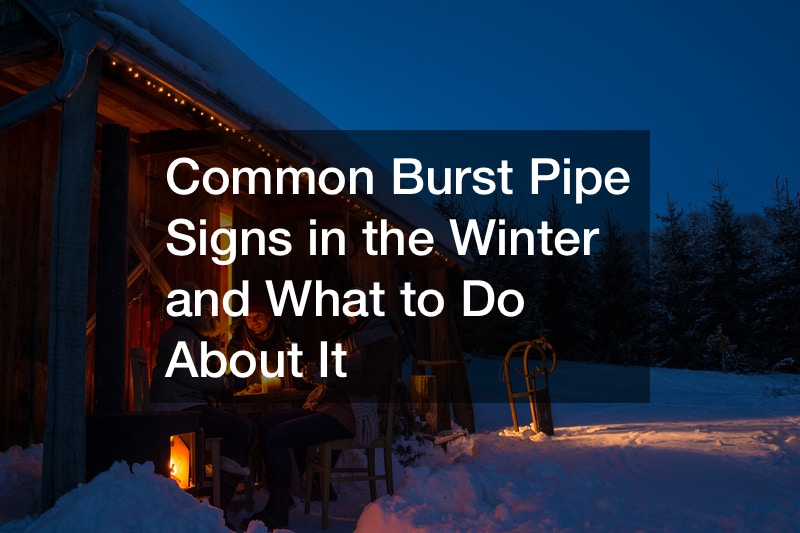

When preparing your home for the winter, there might be several home renovations you might be focusing on. From updating your insulation to cleaning your gutters, replacing any faulty windows or doors, or even buying up all the space heaters you can, these might all be great ways to prepare your home for the winter. Unfortunately, most people might not realize the importance of winterizing their pipes, especially if they just bought a home and moved from a warm climate to a completely new state where it snows. If you live in an area that reaches temperatures below freezing, you will need to prepare for the winter by winterizing and draining your pipes from all water. You will also need to watch out for any signs of burst and frozen pipes throughout the wintertime.
Not winterizing your pipes is a bad move that can be extremely costly. It’s also not a good idea to ignore signs of burst pipes and wait until the last minute to call a plumbing contractor. Not winterizing pipes and ignoring signs of burst pipes can lead to water damage, mold, and other hazards in your home. It’s important to recognize the signs of frozen pipes in addition to doing everything you can to prevent your pipes from bursting this winter season. With a little bit of preparation, you can ensure your home stays comfortable and your family has access to water all winter season.
Why Winterize My Pipes?
Water is, above all else, a chemical that has the unique property of being able to expand in freezing conditions. Once water freezes at 32 degrees Fahrenheit, it will expand in any container it is held in. This is often why you hear people advise you to put a bag of water in your new shoes and put them in the freezer, as the water expands and helps break in your shoes!
Much like water expanding inside of a shoe, water can expand inside of your home’s pipes, leading to extreme leaks and clogged pipes. This is a common occurrence due to tremendous water pressure building up inside of pipes leading to ruptures. Whether you have copper, PVC, or plastic pipes, all of these can be susceptible to bursting during the winter.
It’s best to avoid burst and leaking pipes altogether by winterizing your pipes in your home, as well as taking steps to recognize frozen pipes, thawing them, and preventing them from occurring.
Which Pipes To Look Out For

Not all pipes will be susceptible to bursting or freezing. The pipes you should look for signs of damage include your outdoor sprinkler system, outdoor hose bibs, and any lines that supply water to your pool. Because these pipes are located outside of the home, these will be the first pipes that are in danger of freezing and bursting. It’s important to search up ‘ plumbers in my area‘ to help you winterize these outdoor pipes. Your plumber can also point you in the direction of your water shutoff valve in case there is an emergency and you have to shut off your water supply immediately.
However, it’s not only your outdoor pipes that can become frozen and damaged. Other pipes include those that are in poorly insulated areas of your home. These include pipes located in your basement, garage, crawl space, dens, attics, and those near exterior walls. These include pipes that can run under your kitchen or bathroom cabinet. These pipes are commonly found near the edge of your home’s wall, which leaves them susceptible to freezing cold temperatures outside.
How To Winterize Your Outdoor Pipes
Before we teach you how to recognize the signs of burst pipes, it’s important you learn how to winterize your pipes in order to drain out all remaining water from them. Leaving even a minuscule amount of water in your pipes can cause them to burst, so you’ll want to make sure you drain all water from your pipes beforehand. Because of this, it’s best to start winterizing your pipes during the fall right before the winter season, or sooner if freezing temperatures are imminent.
To winterize your pipes, start by locating your backflow preventer outside the home. It is generally in a hard-to-reach area, such as on the outside of the home or near a crawlspace. The backflow preventer is completely exposed to the elements, and it is used to prevent backflow from contaminated water into the sprinkler system. Once you locate your backflow preventer, you’ll want to shut off the water supply by using its shut-off handles. These are usually bright yellow or red and can be turned using hands or pliers. Turn these one-half or one-quarter as directed on the backflow device. If your home doesn’t have a backflow device, turn off the main water supply to your sprinkler system.
Next, drain any water remaining in your system by releasing the pressure. To do this, locate the two bleeder valves that look like tiny buttons stacked on top of each other, usually on the right hand side of the device. They will have caps on them that you can take off using a flathead screwdriver. After you remove the caps they will burst out water for a couple of seconds, usually at high pressure. Make sure you stay clear of this and stand behind the spewing water, so as to prevent any injuries or getting too wet.
Leave the valves open and the valve off, and your pipes should be protected from bursting and water expansion. If you’re not comfortable doing this process yourself, or you can’t seem to locate your backflow preventer, contact the help of plumbers for advice. They will be able to not only winterize your sprinkler system, but also help you winterize your inground pool.
Inground pools can be tricky to winterize, however, they must be drained due to their high susceptibility to bursting. Winterizing your inground pool requires draining your pool plumbing system as well as ‘blowing out’ your pool lines using an air compressor or shop vac. If you’re not sure where to start, it’s best to get help from a local pool or plumbing company for help. Fortunately, there are several things you can do beforehand to prepare your pool for winter. This includes cleaning your pool so that all debris is removed, covering your pool so that it does not freeze over and gets filled with debris during the winter. You should also check the pH level of your pool and add any pool chemicals to reach a desirable level.
Other Simple Tricks For Preventing Frozen and Burst Pipes

Even after you winterize your outdoor pipes, either with the help of professionals or on your own, there are several simple tips you can use to prevent your pipes from bursting. These include the following.
Insulating your Plumbing
You can easily insulate pipes using several materials. One of the most popular is foam pipe insulation. This material resembles a pool noodle with a slit on one side to fit over your pipe. They can be easily found in any hardware store, and have different dimensions that can fit over any standard size pipe.
You can use this foam insulation on your outdoor irrigation system, or on the outside of your pipes within the basement, den, and any areas that might be susceptible to colder temperatures. In addition, if you recently had water well drilling services and installed a well in your home, you’ll more than likely have above-ground pipes sticking from around your well.
If you have smaller pipes or pipes in hard-reaching areas, you can also use foam insulation tape to cover your pipes. Foam insulation tape is a great way to protect smaller pipes, as well as absorb any water from leaks that might suddenly occur. It can also help insulate your water heater as well.
In addition, did you know that even newspaper can work to insulate your pipes? Even a simple 1/4′ newspaper sheathing around your pipes is enough to keep them from freezing over in the winter!
Yet another simple home renovation project is to install a protective cover around your outdoor backflow preventer. There are simple boxes and covers you can place on the outside of your entire outdoor sprinkler system to keep it protected.
Insulate Your Home
One of the best ways to keep your pipes from freezing over is to make sure they don’t reach temperatures below 32 degrees Fahrenheit. Even your indoor pipes are susceptible to freezing, which is why it’s important to keep them and the rooms they are situated in well insulated. Some rooms you should consider insulating include the garage, the basement, and the attic.
Pipes under your cabinet can also freeze during the winter, especially if you keep the door to your cabinet closed. A simple trick to keep the pipes under your cabinet from freezing is to leave your cabinet doors slightly ajar. This will allow the warm air circulating around your home to penetrate under the cabinet as well. Keep this in mind if you’re doing a bathroom remodel, and opt to protect your pipes and keep them as far away from the cold exterior of your home.
Finally, if you have a thermostat to heat your home, make sure it stays at 55 degrees Fahrenheit even when you’re away from home. This will allow you to keep your home warm and your pipes protected.
Run Your Water Lines
In extremely cold weather, it’s a good idea to turn your faucets on a little, just enough for a tiny drip to form from the faucet. This will allow water to continue to circulate in your pipes and lessen the chances of them freezing and bursting.
Signs of a Frozen Pipe

If you’ve done all of the above, you more than likely won’t have to deal with frozen pipes. However, the biggest sign that your pipes have frozen is the lack of water coming from your faucet. Lack of water pressure indicates you must now thaw your pipes.
If you notice leaks and mold coming from areas near your pipe, this is also a sign of not just a frozen pipe, but a pipe that has burst and is now leaking. These include water pooling around your water heater. If you notice this, it’s important to reach out to a water heater service so they can assess whether the water is due to a burst pipe or a water heater.
Thawing Your Pipes
Perhaps the easiest way to thaw your pipes is through a space heater or blow dryer aiming hot air directly onto the pipe. Trace the line that runs from your main water supply source to the faucet, and this is the pipe that is frozen. Feel around for cold areas, and focus the heat on these areas. Do NOT use an open flame or blow torch, or put antifreeze down your drain. These can all severely damage your pipes and lead to hazardous situations.
While you thaw your pipes, have the faucet open, as this will allow water to flow through the pipe as ice inside of it continues to melt. Finally, wait for the water pressure to build up again. When you achieve full water pressure from your faucet, you’ll know your pipe is fully thawed. It’s a good idea to check other faucets in your home since other pipes can also be frozen.
Seeking Additional Help

It’s relatively easy to find which pipe is frozen. However, if you find yourself unable to trace the frozen pipe, call professional plumber services for help. You should also reach out for help if there’s a leak or burst pipe. Not only should you get the help of plumbers, but also water damage restoration services.
Water damage from a burst pipe can quickly lead to mold and mildew in your home. It can even affect the foundation of your home if the pipe bursts in your basement. You will need extensive water damage cleanup, even after your pipe thaws. Afterward, you can look for services to prevent future water damage, such as waterproofing the surrounding flooring around your pipes.
Preparation goes a long way when it comes to keeping your home safe and comfortable in the wintertime. There’s no better way to protect your home from thousands of dollars in damage than to winterize your pipes. With these tips above, you can not only winterize your pipes but also take extra steps to ensure they don’t freeze and burst.




